The Costa Da Morte

2 – 5 April 2007
I am happy to say that we have made it “around the corner” of north west Spain, safely rounded Cape Finisterre (the almost westerly part of Spain and renowned for bad weather), and we are now tucked up in a nice marina in the first of the Spanish Rias.
On Monday the weather finally looked right to escape from La Coruna; it had stopped raining for at least half an hour. We left on a lovely sunny day, with blue skies and the wind nicely blowing us along from behind. The coastline was beautiful – very rugged, and covered in thick pine forests, though there are nasty rocks all over the place; I can see why it is called the Coast of Death. There were also wind turbines everywhere – a testament to how windy it is around here!
We sailed west for about 40 miles, stopping for the night in a small fishing town called Corme. On the way into the harbour we were welcomed by porpoises gracefully swimming out of the harbour. Unlike the dolphins we encountered the porpoises ignored us completely and swam straight past. They did pose for the camera though! We anchored in the shelter of a pretty little beach in Corme.
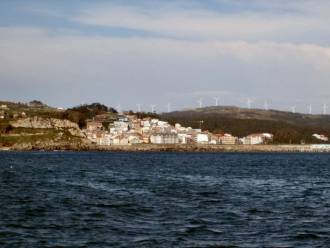

Corme from the sea Porpoises on way into Corme
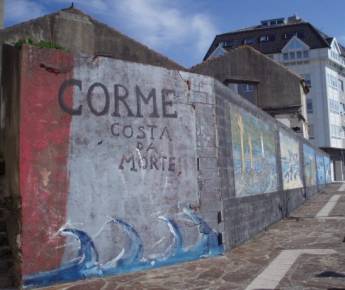
Here there be
dragons!

Rahula at Anchor in
Corme
As soon as we had tidied the boat away James decided it was time to try out his lobster pot, and see if he can catch some dinner. We passed lots of lobster pots and fishermen on the way, so he reckoned he was onto a winner. So over the side it went! After about 10 minutes James had his first catch…
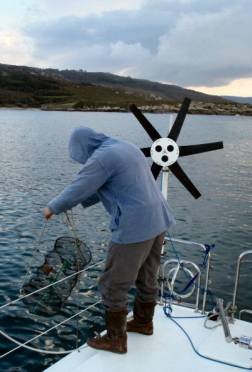
James fishing for lobsters…

James’ first catch in
the lobster pot!
We felt sorry for the little crab, so we let it go. Unfortunately for the rest of the night all his friends wanted a go in the pot, and there was no sign of a lobster, so James gave up.
Disappointed with the lack of lobsters, we weighed anchor and sailed on to the next destination, Camarinas. Despite appearances to the contrary on the Google Earth map we gave the coastline a wide berth, as it was full of nasty almost submerged rocks and shoal patches. I tried to fish again, this time using a line streamed from the stern of the boat, and yet again failed miserably; maybe we were going too fast?. (Does anyone have any advice on how to fish from a yacht?! Please post advice on the message board!) On the way we passed a very dramatic lighthouse, perched high on the cliffs, surrounded by a huge wind farm.
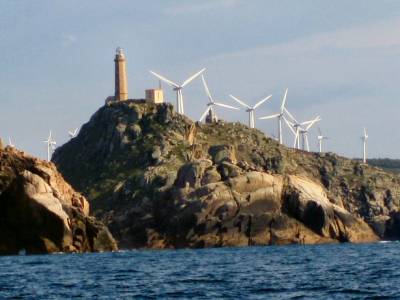
Cabo Villano
Lighthouse & Wind Farm
As we neared the pontoon in Camarinas Marina the engine started coughing and spluttering, then it died completely. James managed to coast the boat in until one of the bows just touched the corner of the pontoon. I leapt ashore with a line, and all was well!
We decided to spend the day in Camarinas, a chance for some R&R and shopping. The town itself was quite lively, and there was music blaring out of speakers in the streets. It was market day, so the town was packed. We found the old part of town which was full of dilapidated old stone houses, and traditional grain stores. The Spanish obviously prefer to rebuild their houses rather than restore. Maybe we should export some of our endless home improvement TV shows to Spain to help them bring some of these buildings back to life?
James and I continued our lighthouse tour with a walk out to the Cabo Villano lighthouse. The path took us through a pine forest that was also an ecological park where all the windmills were based. It was quite a windy day, and it was mesmerising watching them all turn, making a gentle whoosh sound. I thought they looked rather majestic, rising out over the top of the pine trees, quietly generating power for Galicia.


Ecological park wind
farm
On our walk we also saw a ship’s superstructure being used as a garden shed! We are still wondering how they got it up there?!
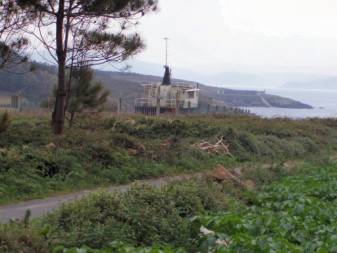
Ship
Shed
The following day it was time to sail around Cape Finisterre. On the morning of our departure the gas bottle ran out, and the galley water pump stopped working, which didn’t bode well! James fitted a new gas bottle while I investigated the water pump. I started with the fuse, which was fine, then I got my voltmeter out and followed the wires to check that there was power to the pump. I am that sort of an engineer, after all! I was mystified why the pump was refusing to work. James came along with lots of “helpful” suggestions, and in the end, he hit the pump with a spanner (in a very technically correct manner – J). And it worked. So I hereby give up being an engineer! Not really…
The sail around Cape Finisterre was glorious. It was a lovely sunny day, there was lots of wind, and Rahula was in her element cruising along comfortably at 8-10 knots downwind. As we rounded the cape we went out of the shelter of the high-sided hills, and it got noticeably windier, so we shortened sail and tacked our way up the harbour to our chosen anchorage in Sardineiro.

Cape
Finisterre
After two weeks here we have finally got used to “Spanish time” (who says you don’t get jet lag sailing!). We don’t tend to get up until 8.30 – 9am (at first light here!), then wander around the shops which open at 10am. Then it is time for lunch at 1pm when everything shuts, and a siesta until 5pm when everything opens again. It doesn’t get dark until 9 in the evening, so late nights tend to be the norm…
My Spanish is also improving greatly, though I haven’t ventured as far as trying to have a conversation. I now get what I am after in the shops, which is progress! Though we did have problems in some of the small fishing towns we visited. The people there speak terrible Spanish, and we couldn’t understand a word!
From here southwards it is allegedly all “plain sailing”, as we explore the Spanish Rias, which are like mini-Solents, with lots of nooks and crannies to explore (and more rocks to avoid!). More on the Rias in the next blog…